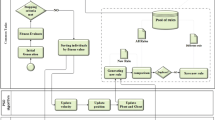Abstract
Mining association rules is an important data mining technology aiming to find the relationship among items in the databases. Genetic-fuzzy data mining uses evolutionary algorithm, such as genetic algorithm (GA), to optimize the membership functions for mining fuzzy association rules, and has received considerable success. The increase in data, especially in big data analytics, poses serious challenges to GA in the effectiveness and efficiency of finding appropriate membership functions. This study proposes a GA for enhancing genetic-fuzzy mining of association rules. First, we design a novel chromosome representation considering the structures of membership functions. The representation facilitates arrangement of membership functions. Second, this study presents two heuristics in the light of overlap and coverage for removing inappropriate arrangement. A series of experiments is conducted to examine the proposed GA on different amounts of transactions. The experimental results show that GA benefits from the proposed representation. The two heuristics help to explore the structures of membership functions and achieve significant improvement on GA in terms of solution quality and convergence speed. The satisfactory outcomes validate the high capability of the proposed GA in genetic-fuzzy mining of association rules.






Similar content being viewed by others
References
Agrawal R, Imielinski T, Swami AN (1993) Mining association rules between sets of items in large databases. In: Proceedings of the ACM SIGMOD International Conference on Management of Data
Agrawal R, Srikant R (1994) Fast algorithms for mining association rules. In: Proceedings of the international conference on very large data bases, pp 487–499
Alcalá-Fdez J, Alcalá R, Herrera F (2011) A fuzzy association rule-based classification model for high-dimensional problems with genetic rule selection and lateral tuning. IEEE Trans Fuzzy Syst 19(5):857–872
Antonelli M, Ducange P, Marcelloni F (2014) A fast and efficient multi-objective evolutionary learning scheme for fuzzy rule-based classifiers. Inf Sci 283(1):36–54
Asadollahpoor-Chamazi M, Minaei-Bidgoli B, Nasiri M (2013) Deriving support threshold values and membership functions using the multiple-level cluster-based master-slave IFG approach. Soft Comput 17(7):1227–1239
Cai G-R, Li S-Z, Chen S-L (2010) Mining fuzzy association rules by using nonlinear particle swarm optimization. Quant Log Soft Comput 82:621–630
Chan K, Au WH (1997) Mining fuzzy association rules. In: Proceedings of the international conference on information and knowledge management, pp 209–215
Chang C-C, Lin C-J (2011) LIBSVM: a library for support vector machines. ACM Trans Intell Syst Technol 2(27):1–27
Chen C-H, Li A-F, Lee Y-C (2013) A fuzzy coherent rule mining algorithm. Appl Soft Comput 13(7):3422–3428
Chen C-H, Tseng V-S, Hong T-P (2008) Cluster-based evaluation in fuzzy-genetic data mining. IEEE Trans Fuzzy Syst 16(1):249–262
Fayyad UM, Piatetsky-Shapiro G, Smyth P (1996a) From data mining to knowledge discovery in databases. AI Mag 17:37–54
Fayyad UM, Piatetsky-Shapiro G, Smyth P (1996b) Advances in knowledge discovery and data mining. In: From data mining to knowledge discovery: an overview, AAAI, pp 1–34
Fazzolari M, Alcala R, Nojima Y, Ishibuchi H, Herrera F (2013) A review of the application of multiobjective evolutionary fuzzy systems: current status and further directions. IEEE Trans Fuzzy Syst 21(1):45–65
Herrera F, Lozano M, Verdegay JL (1997) Fuzzy connectives based crossover operators to model genetic algorithms population diversity. Fuzzy Sets Syst 92(1):21–30
Hong T-P, Chen C-H, Lee Y-C, Wu Y-L (2008) Genetic-fuzzy data mining with divide-and-conquer strategy. IEEE Trans Evol Comput 12(2):252–265
Hong T-P, Chen C-H, Wu Y-L, Lee Y-C (2006) A GA-based fuzzy mining approach to achieve a trade-off between number of rules and suitability of membership functions. Soft Comput 10(11):1091–1101
Hong T-P, Kuo C-S, Chi S-C (1999) Mining association rules from quantitative data. Intell Data Anal 3(5):363–376
Hong T-P, Lee C-Y (1996) Induction of fuzzy rules and membership functions from training examples. Fuzzy Sets Syst 84(1):33–47
Kuok CM, Fu A, Wong MH (1998) Mining fuzzy association rules in databases. ACM SIGMOD Rec 27(1):41–46
Lee CK-H, Choy K-L, Ho GT-S, Lam CH-Y (2016) A slippery genetic algorithm-based process mining system for achieving better quality assurance in the garment industry. Expert Syst Appl 46:236–248
Lee CK-H, Ho GT-S, Choy K-L, Pang GK-H (2014) A RFID-based recursive process mining system for quality assurance in the garment industry. Intern J Prod Res 52(14):4216–4238
Liu B, Hsu W, Chen S, Ma Y (2000) Analyzing the subjective interestingness of association rules. IEEE Intell Syst Their Appl 15(5):47–55
Meng D, Pei Z (2012) Extracting linguistic rules from data sets using fuzzy logic and genetic algorithms. Neurocomputing 78(1):45–54
Minaei-Bidgoli B, Barmaki R, Nasiri M (2013) Mining numerical association rules via multi-objective genetic algorithms. Inf Sci 233(1):15–24
Mishra S, Mishra D, Satapathy SK (2011) Particle swarm optimization based fuzzy frequent pattern mining from gene expression data. In: Proceedings of the international conference on computer & communication technology, pp 15–20
Piatesky-Shapiro G, Brachman R, Klösgen W, Simoudis E (1996) An overview of issues in developing industrial data mining and knowledge discovery applications. In: Proceedings of knowledge discovering and data mining, pp 89–95
Qodmanan HR, Nasiri M, Minaei-Bidgoli B (2011) Multi objective association rule mining with genetic algorithm without specifying minimum support and minimum confidence. Expert Syst Appl 38(1):288–298
Rudzinski F (2016) A multi-objective genetic optimization of interpretability-oriented fuzzy rule-based classifiers. Appl Soft Comput 38:118–133
Srikant R, Agrawal R (1996) Mining quantitative association rules in large relational tables. ACM SIGMOD Rec 25(2):1–12
Wagstaff K, Cardie C, Rogers S, Schroedl S (2001) Constrained K-means clustering with background knowledge. In: Proceedings of the international conference on machine learning, pp 577–584
Wakabi-Waiswa P, Baryamureeba V (2008) Extraction of interesting association rules using genetic algorithms. Int J Comput ICT Res 2:1139–1818
Acknowledgments
The authors would like to thank the editor and reviewers for their valuable comments and suggestions.
Author information
Authors and Affiliations
Corresponding author
Ethics declarations
Conflict of interest
The authors declare that they have no conflict of interest.
Ethical approval
This article does not contain any studies with human participants or animals performed by any of the authors.
Additional information
Communicated by C.-H. Chen.
Rights and permissions
About this article
Cite this article
Ting, CK., Wang, TC., Liaw, RT. et al. Genetic algorithm with a structure-based representation for genetic-fuzzy data mining. Soft Comput 21, 2871–2882 (2017). https://doi.org/10.1007/s00500-016-2266-z
Published:
Issue Date:
DOI: https://doi.org/10.1007/s00500-016-2266-z




